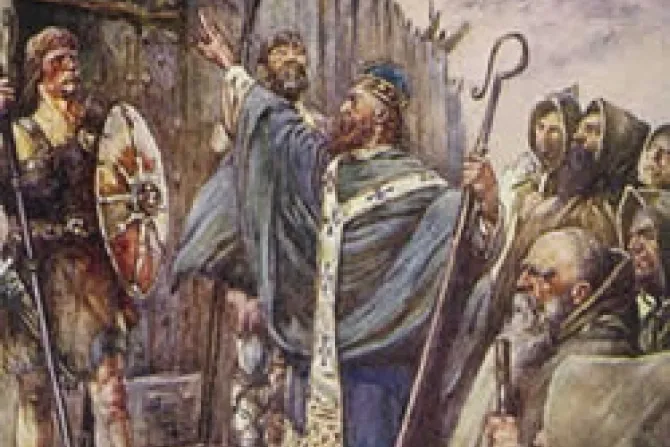Denver, Colorado, Jun 9, 2013 / 05:06 am
On June 9 the Catholic Church commemorates the sixth-century Irish monk and missionary Saint Columba of Iona, also known as St. Columcille.
One of Ireland's three patron saints (together with Saint Patrick and Saint Brigid), he is also sometimes called the "Apostle of the Picts" for his evangelization of Scotland.
He should not be confused with St. Columbanus (or Columban), a different Irish monk and missionary who lived slightly later and ended up in Italy.
Columba was born during 521, descended from royalty through his father. He was taught and mentored by the priest who baptized him, and later attended a monastic school founded by Saint Finnian of Moville. His own life as a monk began at the school, where he was also ordained a deacon.
The deacon went on to spend time in a different monastery and school run by another Finnian, Saint Finnian of Clonard. Columba became a priest during this period, and along with eleven others from this same institution, he would become known as one of the "Twelve Apostles of Ireland."
Columba also studied with Saint Mobhi of Glasnevin, before a disease epidemic forced him to return to his ancestral homeland of Ulster during 544. He spent the next 15 years traveling, preaching, and founding monasteries.
It is not clear why, in 563, Columba left Ireland. By some accounts he was simply going to preach the word of God. Others claim that he had become involved in a battle between warring tribes, before repenting and taking on foreign missionary work as a penance.
On the island of Iona, located on Scotland's northwest coast, Columba and his group of companions built simple monastic quarters and a church for themselves. The priest-monk's first missionary work was in the region of Dalriada, whose Celtic Christian inhabitants were lacking solid religious instruction.
His next effort was to convert the Picts of northern Scotland, a task that would take up most of the rest of his life. He began by gaining entrance to the castle of King Brude, where the locked gates are said to have miraculously opened when the sign of the Cross was made. The king welcomed the missionaries, believed the Gospel, and was baptized.
Columba's evangelization of northern Scotland continued over the next three decades. He and his companions met with some resistance from the native pagan Druids, but on the whole they found remarkable success in spreading the Catholic faith and building up a network of churches and monasteries.
The island monastery at Iona remained his home base, and it drew pilgrims looking to benefit from the priest-monk's wisdom and his prayers. He remained in touch with the Irish Church, making many trips back until he became too weak to travel. Even in old age, Columba maintained an intense routine of prayer, fasting, and study.
After giving a final blessing to his monastery on June 8, 597, he died sometime in the early hours of the following day.


